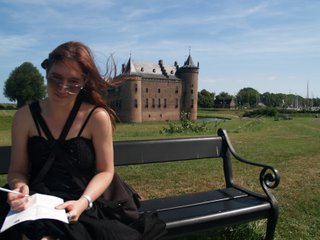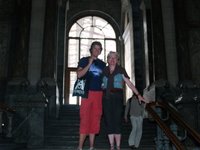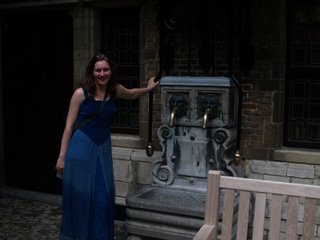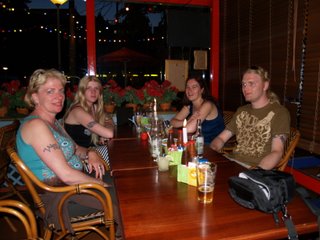Storming the Muiderslot
It was the 14th of July. The day was bright and sunny as the two intrepid adventurers exited Weesp train station and, apon seeing the bus they needed standing there at the bus stop, raced over the station forcourt only to have the bus driver patently ignore them and drive off.
So much for re-enacting Bastille day!
Our enthusiasm for a good storming now thwarted we went in search of other means of getting to Muiden and found a very friendly, very willing old dame of a taxi-driver to get us to Muiden in fine style and along the way provide us with many interesting tidbits of info about the area.
She dropped us off just outside Muiden, as in her opinion it was well worth the short walk through the small town. She was right. Muiden is, in a word, adorable! I was also immediately aware that the Ducth as a race were not always as tall as the modern day dutch people are made out to be. The houses are all small and compact and my dearest Baz would have a hard time getting in and out of most of these places and he is about half a head taller than most of the doors!
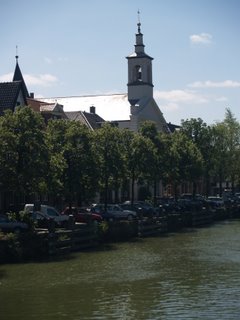
About halfway to the castle, Muiderslot, itself there is the proper 'slot' or lock where small boats can leave the marina and head out onto larger waters. Its a graceful old revolving bridge lock that allows traffic through on two sides. I think mum's boat could just about squeeze through but Koos would have a hard time with the Luxor! After admiring the lock and taking a few pictures we decided to have lunch at a small pub next to the water before heading up to the castle. The fare was simple but tasty and I was very glad of the nice cold beer as by now it the sun was well and truly up!
After admiring the lock and taking a few pictures we decided to have lunch at a small pub next to the water before heading up to the castle. The fare was simple but tasty and I was very glad of the nice cold beer as by now it the sun was well and truly up!
Next it was off to do the now rather relaxed version of storming the castle.
First a historical tidbit or two: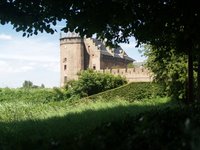
The castle Muiderslot was first built in 1280 by Count Floris V but its most interesting resident is, in my opinion, the dutch literary icon P.C. Hooft who was mayor in these parts from 1609 until his death in 1647 (It is speculated that his father's friendship with Prince Mauritz was the true reason for his being awarded the position of mayor as the family were not nobles by birth but a wealthy merchant family). Along with being mayor he also held the positions of Bailiff of Naarden and Gooiland and Chief Officer of Weesp but his real passion was writing and literature, something which is, of course, also a passion of mine. He wrote books of poetry as well as prose and his name is still remembered today in the form of the P.C. Hooft literary prize. The guided tour through the newly restored living quarters of the castle was also a treat as it gave a very detailed insight into what living in castle was really like during the middle-ages. The draftiness, the lack of light and the stink; the fact that as many as 6 people would sleep in bed that quite frankly is not really big enough for two people to sleep comfortably really surprised me until the guide explained that the mother and father would sleep sitting up against each other and only the childeren would lie down. The reason for this? Back in the day it was believed that if adults lay down all the blood in their bodies would rush to their heads and push their brains into a corner and it would damage your common sense. Children, of course, were devoid of common sense and therefore their brains didn't need to be protected!
The guided tour through the newly restored living quarters of the castle was also a treat as it gave a very detailed insight into what living in castle was really like during the middle-ages. The draftiness, the lack of light and the stink; the fact that as many as 6 people would sleep in bed that quite frankly is not really big enough for two people to sleep comfortably really surprised me until the guide explained that the mother and father would sleep sitting up against each other and only the childeren would lie down. The reason for this? Back in the day it was believed that if adults lay down all the blood in their bodies would rush to their heads and push their brains into a corner and it would damage your common sense. Children, of course, were devoid of common sense and therefore their brains didn't need to be protected!
We were also show the origins of many interesting dutch sayings in the kitchen area: for example "Hou je waffel" or "keep your mouth shut" actually stems from the use of a waffle iron that children used to bake their waffles with over the open fire and if they didn't keep quiet and keep an eye on their special treats, they would burn.
 With the tour over we spent the remainder of the afternoon scrambling up and down tower stairs and exploring the gardens, looking at falcons and generally enjoying ourselves. The castle is beautifully restored and maintained and its easy to see why the staff working there consider it the most beautiful castle in the Netherlands.
With the tour over we spent the remainder of the afternoon scrambling up and down tower stairs and exploring the gardens, looking at falcons and generally enjoying ourselves. The castle is beautifully restored and maintained and its easy to see why the staff working there consider it the most beautiful castle in the Netherlands.
All in all it was a grand day out and a great birthday excursion!
